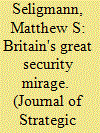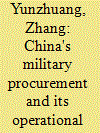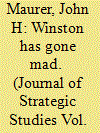|
|
|
Sort Order |
|
|
|
Items / Page
|
|
|
|
|
|
|
| Srl | Item |
| 1 |
ID:
117948


|
|
|
|
|
| Publication |
2012.
|
| Summary/Abstract |
This article challenges the conventional wisdom that Neville Chamberlain rejected the British tradition of balance of power in the 1930s. In contrast to balance of power and balance of threat theories, states do not balance against aggregate or net shifts in power. Instead, leaders define threats based on particular elements of a foreign state's power. The import is that different components of power of a foreign state are more or less threatening and aggregate shifts in power alone may not provoke counterbalancing behavior. In the 1930s, Britain balanced against the most threatening components of power: the German Luftwaffe and the threat of a knock-out air assault against the homeland, Japan's Imperial Navy and its threat to Britain's commercial trade routes and the Dominions in East Asia, and the Italian Navy and the threat to Britain's line of communication through the Mediterranean Sea to India and Asia. Given Britain's difficult financial circumstances, all other components of power, such as the army and the land components of power of Germany, Japan, and Italy were ranked as secondary in terms of its rearmament priorities. Thus, London was able to narrow the gap with Berlin in specific components of power of strategic importance such as aircraft production or to exceed Germany in other areas such as the Royal Navy and its battlefleet.
|
|
|
|
|
|
|
|
|
|
|
|
|
|
|
|
| 2 |
ID:
117952


|
|
|
|
|
| Publication |
2012.
|
| Summary/Abstract |
This article focuses on the relationship between the threat perception analyses of the British Admiralty and the strategic orientation of the Royal Navy at the outset of the twentieth century. The current view is that this was an era when fear of France and Russia drove British naval policy. However, as this article will show, Britain's Naval Intelligence Department formed a low opinion of French and Russian naval capabilities at this time and this negative evaluation exerted considerable influence over decision making. The belief that, owing to multiple qualitative deficiencies, these powers could definitely be beaten in battle lessened the standing of the Franco-Russian naval challenge and freed the Admiralty to consider the danger posed by other possible enemies, most notably Germany.
|
|
|
|
|
|
|
|
|
|
|
|
|
|
|
|
| 3 |
ID:
117950


|
|
|
|
|
| Publication |
2012.
|
| Summary/Abstract |
Using the German Army from 1916 to 1918 as a case study, this article demonstrates a different form of military innovation than has hitherto been analysed by literature on the subject. During World War I, the German Army innovated by spreading knowledge between units rather than up and downthe chain of command. Thus, this army used 'horizontal innovation', rather than vertical innovation to change how it fought in the midst of battle. Although combat in World War I is significantly different from operations today, horizontal innovation offers armed forces a means by which to transform themselves much more rapidly than the traditionally recognised forms of military innovation.
|
|
|
|
|
|
|
|
|
|
|
|
|
|
|
|
| 4 |
ID:
117953


|
|
|
|
|
| Publication |
2012.
|
| Summary/Abstract |
This article is a response to Evron's argument, offering readers another perspective to assess China's military modernization and war fighting capabilities, using the same framework and methodology. It examines three topics: China's national security and military strategy, the PLA's procurement decision-making process, and China's military support and mobilization system. It concludes that, China's military modernization is to fight and win local wars under the conditions of informatization, but if required the PLA can reliably supply large numbers of sophisticated weapons and spare parts, to wage a complex and prolonged conflict.
|
|
|
|
|
|
|
|
|
|
|
|
|
|
|
|
| 5 |
ID:
117951


|
|
|
|
|
| Publication |
2012.
|
| Summary/Abstract |
This article analyses the evolution of permanent fortifications in Europe between 1870 and 1914. Despite the introduction in the 1880s of high explosive shells, intensive construction continued until the eve of war. Fortifications figured prominently in armaments budgets and in offensive as well as defensive strategic planning, while their design changed radically. Nonetheless, the pattern of development worked against the Central Powers. Austria-Hungary concentrated against Italy at the expense of the Balkans and Galicia; Germany concentrated on Alsace-Lorraine, neglecting the east until 1912. Whereas France modernised its eastern fortresses, Belgium did little, enticing Germany into the envelopment strategy that would draw Britain into the First World War.
|
|
|
|
|
|
|
|
|
|
|
|
|
|
|
|
| 6 |
ID:
117949


|
|
|
|
|
| Publication |
2012.
|
| Summary/Abstract |
As Chancellor of the Exchequer during the late 1920s, Winston Churchill was at the center of British strategic decision making about how to respond to the naval challenge posed by Japan's rise as a rival sea power. Churchill downplayed the likelihood of war with Japan. The leadership of the Royal Navy disagreed: they saw Japan as a dangerous threat to the security of the British Empire. Examining this dispute between Churchill and the Admiralty highlights the awkward political, economic, and strategic tradeoffs confronting British leaders between the world wars.
|
|
|
|
|
|
|
|
|
|
|
|
|
|
|
|
|
|
|
|
|